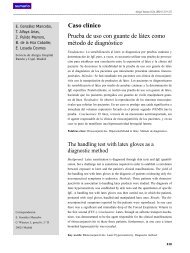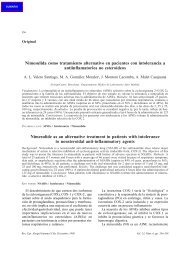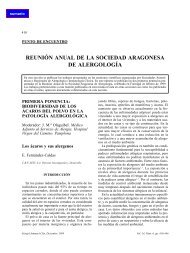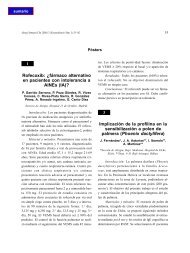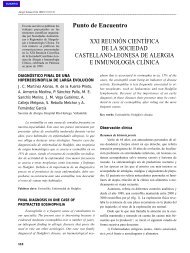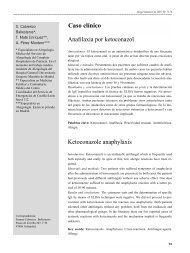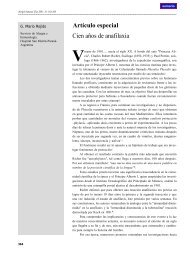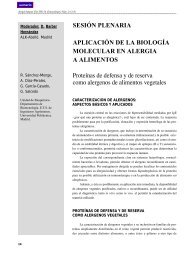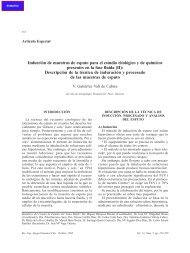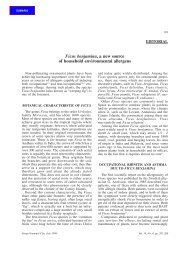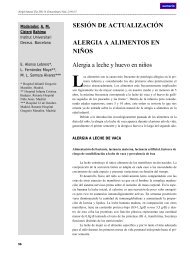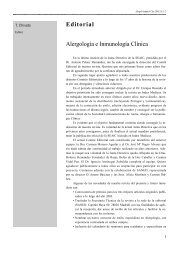Antihistamines: a review
Antihistamines: a review
Antihistamines: a review
Create successful ePaper yourself
Turn your PDF publications into a flip-book with our unique Google optimized e-Paper software.
No. 5 H1 <strong>Antihistamines</strong>: a <strong>review</strong> 303<br />
HO N<br />
CH 3<br />
N<br />
CH CH<br />
N<br />
C CH CH 2<br />
ACRIVASTINE<br />
ACRIVASTINA<br />
CH 2 CH 2 CH 2 CH C<br />
TERFENADINA<br />
TERFENADINE<br />
O<br />
LORATADINA<br />
LORATADINE<br />
SEGUNDA SECOND-GENERATION GENERACIîN DE ANTAGONISTAS H1 RECEPTOR ANTAGONISTS<br />
DE RECEPTORES H1 Fig. 1b. Primary structure of histamine and of various H1 antihistamines.<br />
correlation between the degree of inhibition of the<br />
skin response and the clinical efficacy of the<br />
various drugs.<br />
All the "classical" antihistamines and also many<br />
of the second-generation ones (terfenadine 29 , ebastine<br />
30 , astemizole 31 , loratadine 26 , mizolastine 32 ) are<br />
metabolised to a greater or lesser extent by the<br />
hepatic cytochrome p-450 system (CYP), a fact of<br />
utmost importance in the development of drug interactions<br />
and drug toxicity. The CYP is an enzymatic<br />
system responsible for drug metabolism and<br />
detoxification present in the liver and in other tissues,<br />
and its constituent isoenzymes are classified<br />
into "families" according to the similarity of their<br />
aminoacid sequences 33 . As a result of genetic variability,<br />
the number of p-450 isoenzymes varies, and<br />
each drug is metabolised in a different manner 15 .<br />
Astemizole or terfenadine are metabolised by the<br />
3A4 family (CYP3A4). Within this same family,<br />
some substances can behave as enzymatic inhibitors<br />
while others act as enzyme substrates, and this<br />
OH<br />
N C O CH2CH2 O<br />
C OH<br />
HO N CH 2 CH 2 CH 2 C<br />
Q<br />
Q HCl<br />
N<br />
OH<br />
FEXOFENADINE<br />
FEXOFENADINA<br />
CH 3<br />
C<br />
CH 3<br />
CH 3<br />
CH 3<br />
CH 3<br />
COOH<br />
CH 2<br />
O<br />
AZELASTINE<br />
AZELASTINA<br />
N<br />
N<br />
N<br />
Cl<br />
CH N N CH2 CH2 O CH2 C OH<br />
CH 3<br />
ASTEMIZOLE<br />
ASTEMIZOL<br />
LEVOCABASTINE<br />
LEVOCABASTINA<br />
HC O<br />
N CH2 CH2 CH2 C C<br />
HC O<br />
EBASTINE<br />
EBASTINA<br />
N CH 2 CH 2 CH 2 C C<br />
CAREBASTINE<br />
CAREBASTINA<br />
F<br />
NC<br />
gives rise to multiple interactions 33 . Table III summarises<br />
some inhibitors and substrates of the<br />
CYP3A4. It should be noted that natural flavonoids<br />
present in grape juice may also inhibit the 3A4<br />
family 33,34 and that erythromycin is at the same time<br />
inhibitor and substrate for the CYP3A4 33 .<br />
On the other hand, erythromycin is by itself<br />
able to block some potassium channels in the<br />
myocardium 35 . This might be fundamental, as will<br />
be explained later, in its interactions with some<br />
antihistamines.<br />
SIDE EFFECTS ON THE<br />
CARDIOVASCULAR SYSTEM<br />
The potential cardiotoxicity of antihistamines<br />
was first reported in relation with astemizole 36 and<br />
later with terfenadine 37 . Considerable attention was<br />
focused on the latter drug, however, possibly because<br />
it was the most widely used one in the USA 38 .<br />
O<br />
N<br />
H<br />
O<br />
H<br />
CH 3<br />
CH 3<br />
CH 3<br />
CH 3<br />
CH 3<br />
O<br />
O<br />
C OH<br />
CH 3<br />
COOH




